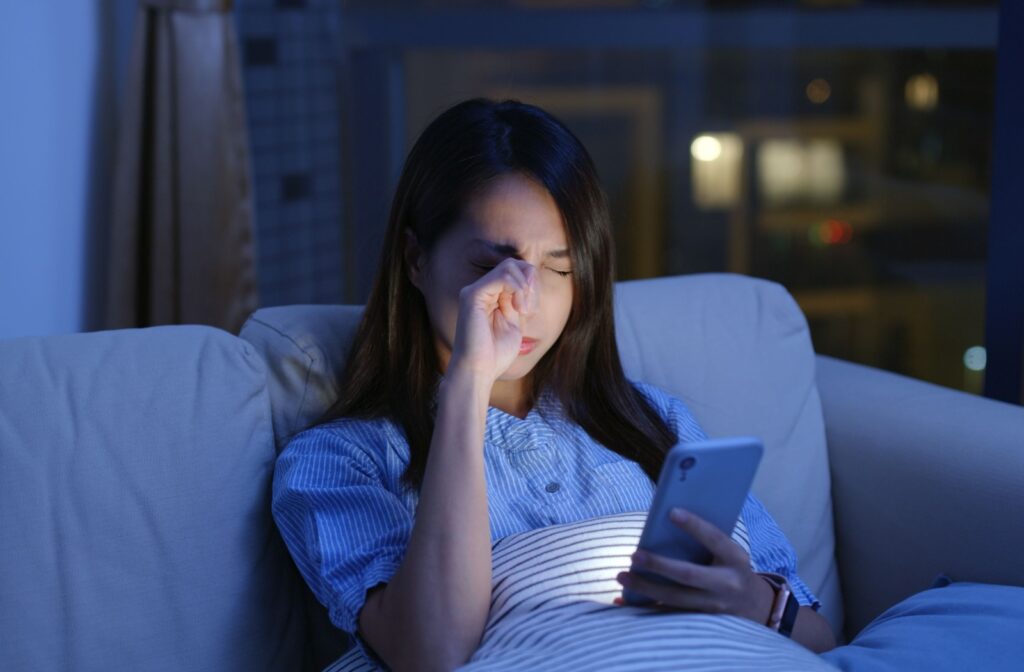You may have heard of radiofrequency treatment (RF) in the context of aesthetic treatments. But did you know RF can also be used to treat dry eye? RF is a nonsurgical treatment that uses heat generated by electricity to unblock glands in the eyelids and reduce inflammation. It’s a simple and relatively quick in-clinic procedure, and you can expect to return to your usual activities shortly after treatment.
To understand how RF works, it helps to first understand the biology behind dry eye and meibomian gland dysfunction (MGD). Note that RF is not the only treatment for dry eye; eye drops, medications, meibomian gland expression, and other methods can also be effective.
Understanding the Basics of Dry Eye
Dry eye is a common condition. It happens when you don’t produce enough tears, or when the tears you do produce lack the proper composition. Our tears are composed of three layers: oil, water, and mucus. When these materials are out of balance, dry eye symptoms may develop.
People who are more likely to experience dry eye include:
- Older adults
- Women (due to hormonal changes)
- Contact lens wearers
- Those with certain underlying medical conditions, including rheumatoid arthritis, thyroid problems, and diabetes
- Individuals who take certain medications, including antihistamines, antidepressants, and blood pressure medication
- Patients who have undergone laser eye surgery
- People who spend time in environments with dry eye triggers, such as windy, smoky, or low-humidity spaces
Dry eye symptoms include:
- Feelings of irritation, scratchiness, or burning
- Red eyes
- Watery eyes
- Blurry vision
- Mucus discharge
- Sensitivity to light
Meibomian Gland Dysfunction
One common cause of dry eye is meibomian gland dysfunction (MGD). Your meibomian glands produce the oily layer of your tears, which helps prevent your tears from drying out too quickly. In people with MGD, the meibomian glands are blocked or don’t produce an adequate quality of oil. Medications for eye conditions and some hormonal treatments can affect the quality of tears your meibomian glands produce.
Dry eye and MGD can become serious if left untreated. MGD that isn’t treated can even lead to corneal damage.
What is Radiofrequency (RF) Treatment?
During radiofrequency treatment, a provider uses a handheld device to send high-frequency electrical currents into the patient’s skin. The heat generated by these currents stimulates collagen production, which can support the skin’s elasticity. This heat can also unclog the patient’s blocked meibomian glands and reduce inflammation in the eyelids.
The treatment generally lasts 10 to 20 minutes, with a little extra time for preparation. However, you can expect to return to your usual activities immediately after treatment; there’s no downtime required. RF treatment involves multiple sessions, but results can be seen within 3 to 4.
Radiofrequency Benefits & Risks
Radiofrequency is a non-surgical procedure, which means it can be done in the comfort and convenience of an optometry clinic. There are no needles involved, and you shouldn’t expect much discomfort. If you do experience pain, let your provider know.
Like any other medical procedure, RF comes with risks. These are typically minor, however. For example, you may experience some redness and swelling around your eyelids after the procedure. These effects should go away within a few hours.
RF has shown promising results, but because it’s a relatively new therapy, more research is needed. One small, 2018 randomized study on 10 patients showed a strong success rate. If you have questions or concerns, talk to your optometrist. They should be able to give you more details on what to realistically expect.

Other Ways to Treat Dry Eye
Radiofrequency isn’t your only option when it comes to dry eye relief. There are many methods available, including:
- Lifestyle changes: Staying hydrated, limiting screen time, and getting enough sleep can help with symptoms. Also, consider altering your environment, such as placing a humidifier in your room or avoiding windy and smoky spaces.
- Eye drops: Some eye drops are available over-the-counter; others must be prescribed. We strongly suggest speaking to an optometrist before trying new medications, especially if you have other medical conditions or take other medicines, as drugs and conditions sometimes interact. You can learn more about the eye drops we prescribe here.
- Eyelid care: Certain medications and tools can help clean the eyelids, which then support the proper function of your meibomian glands.
- Meibomian gland expression: An optometrist can gently massage your eyelids to directly express clogged oil from the meibomian glands.
- Anterior segment photography: If your dry eye isn’t related to the tear film, but to the surface of your eye, we can use anterior segment photography to further assess your eye.
Manage Dry Eye in Colorado Springs
Dry eye may seem like a minor issue, but it’s not just uncomfortable and annoying. Untreated dry eye can lead to complications. You deserve to see clearly and comfortably, and even a seemingly minor symptom like scratchy eyes can significantly impact school, work, and recreational activities. Dry eye is common among Coloradans, thanks to the high altitude and dry climate we live in. At Eye Care Center of Colorado Springs, we strive to bring clear and comfortable vision to Coloradans struggling with dry eye. To learn more about how we can help you, book an appointment with us today.


